Pioneer DDJ-SZ2
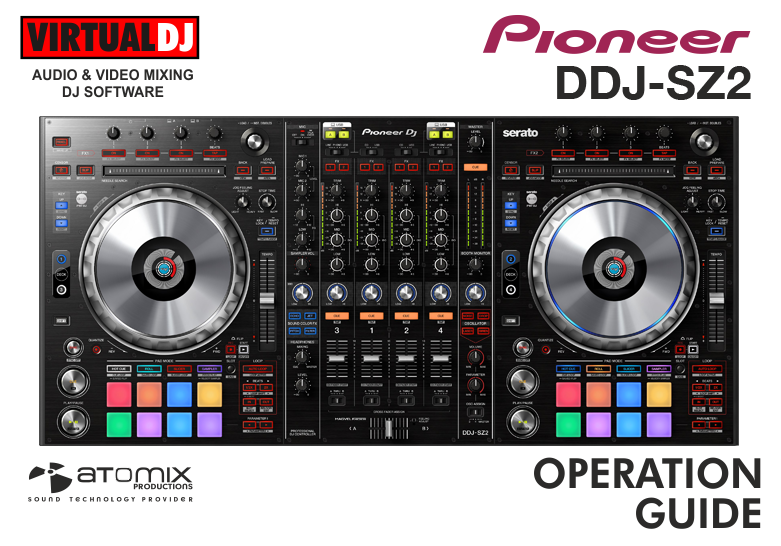
INSTALLATION
Firmware & Drivers
Firmware: Update the firmware of the unit to the latest version from https://www.pioneerdj.com/en/product/controller/ddj-sz2/black/support/#info
Drivers: Install the latest drivers (for both Windows and Mac OSX computers) from https://www.pioneerdj.com/en/support/software/ddj-sz2/#drivers
VirtualDJ 8 Setup
Once VirtualDJ 8 is launched, a Login Window will appear. Login with your virtualdj.com account.
A Pro Infinity or a Pro Subscription License is required to fully use the Pioneer DDJ-SZ2. Without any of the above Licenses, the controller will operate for 10 minutes each time you restart VirtualDJ.
http://www.virtualdj.com/buy/index.html

Click on the "Use Soundcard" button in order VirtualDJ to apply the pre-defined audio configuration. Keep in mind that due to the nature of the unit, speakers need to be connected to the Master Output of the DDJ-SZ2 and the pre-defined audio configuration to be used.
Click to OK.
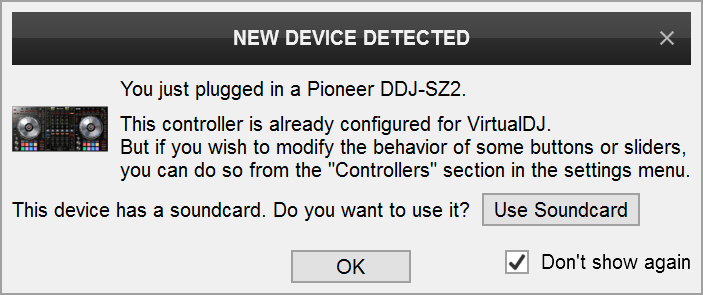
The unit is now ready to operate.
MIDI Operation
Find more details at
http://www.virtualdj.com/wiki/VDJ8script.html
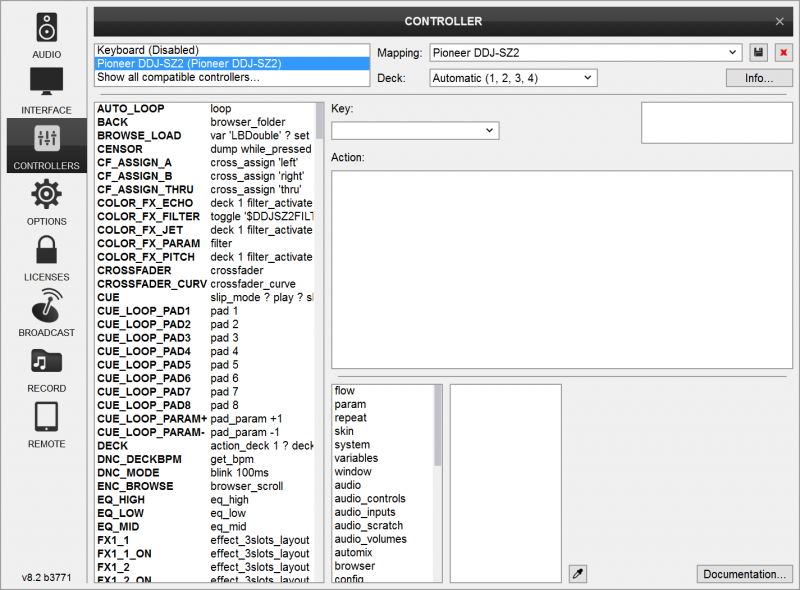
AUDIO Setup
The unit has a pre-defined Audio setup and a special button in the AUDIO tab of Config to provide that. Alternative Audio setups can be applied in the same window.
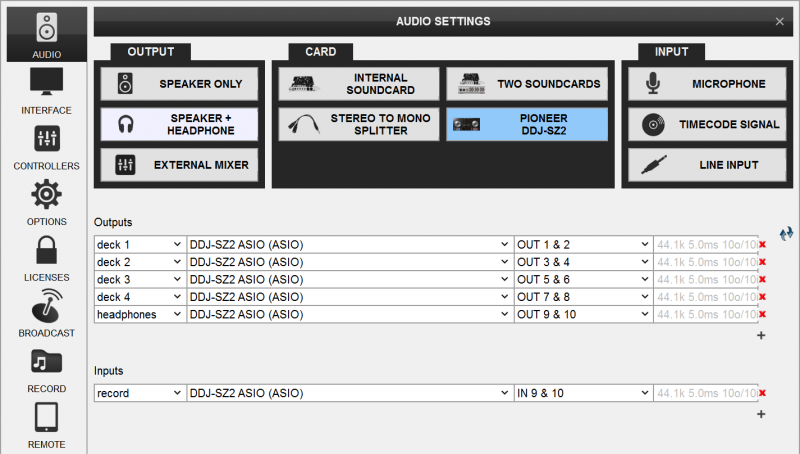
For further software settings please refer to the User Guide of VirtualDJ 8.
http://www.virtualdj.com/manuals/virtualdj8/index.html
LAYOUT
S SHIFT: Hold this button down to access secondary functions of Pioneer DDJ-SZ2 (mainly in black lettering inside a gray box)

The functionality of each button, knob and slider per section (as shown in the image above) will be explained in detail in the next chapters
Mixer
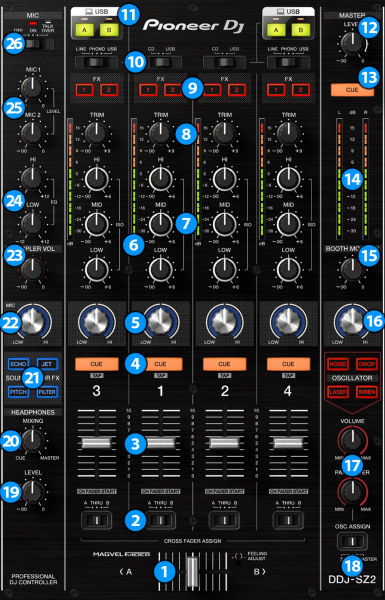
- CROSSFADER. Blends audio between the channels assigned to the left and right side of the crossfader.
- CROSSFADER CH ASSIGN. Define if a mixer channel will be output regardless of the position of the crossfader (THRU position) or Left/Right.
- VOLUME. Adjust the Volume of each channel. While SHIFT is held down, the VOLUME faders will stop the deck at the previously selected Cue when these reach the minimum level (zero) and will start the deck (synced to the other deck) if those move from the zero position. (Fader Start)
- CUE (PFL) (per channel) Press these buttons to send each channel to the Headphones Output channel.
- COLOR FX PARAMETER. Adjust the parameter of the selected COLOR FX for each channel. When in middle position, the COLOR FX has no effect on the sound.
- CH INPUT VUMETER. Shows each channels input (pre fader) volume.
- HIGH/MID/LOW (EQ). Adjust the High, Mid and Low frequencies for each mixer channel.
- TRIM. Adjust the Gain of each mixer channel. Note that the "zero gain / park" position is 12 o clock.
- FX ASSIGN. Copy applied effects from one deck to another. See EFFECTS
- INPUT SELECTORS. Define the source of each Channel. Put the switchers to USB position for software mixing.
- USB. Define if the Left or Right channels of the DDJ-SZ2 mixer will be controlled by the computer connected to the USB A port or the computer to USB B port. Use these buttons to do seamless transitions between 2 dj's with different computers connected on DDJ-SZ2 USB ports.
- MASTER VOLUME. Adjust the level of the Master Output. Hardware operation but movement visible on the VirtualDJ GUI
- MASTER CUE (PFL). Send the Master Output of the unit to the Headphones Output channel. Please note that in order to hear the Master Output on your headphones you must also turn the HEADPHONES MIXING (20) knob to the desired position.
- MASTER OUTPUT VUMETER. Shows the master output volume of the unit. Hardware operation.
- BOOTH MONITOR. Adjust the level of the Booth Output of the DDJ-SZ2. Hardware operation, not visible on the VirtualDJ GUI.
- MASTER COLOR FX PARAMETER. Adjust the Color FX of the master sound output. Hardware operation, not visible on VirtualDJ GUI.
- OSCILATOR. Internal OSCILATOR generator of the DDJ-SZ2
Hardware operation, not visible on the VirtualDJ GUI nor affect the software Sampler. Read further details on the unit’s operation manual. - OSCILATOR ASSIGN SWITCH. Select whether the OSCILLATOR SAMPLER section of DDJ-SZ2 will output it's volume on deck 3, 4 or Master output.
- HEADPHONES VOLUME. Adjust the volume of the Headphones Channel.
- HEADPHONES MIXING. Adjust how the Channels and the Master Output blend at the Headphones Channel. Hardware operation, but movement visible on the VirtualDJ GUI.
- SOUND COLOR FX. Select one of the predefined Color Effects (Echo, Jet, Pitch and Filter).
- SAMPLER COLOR FX PARAMETER. This knob is not used by VirtualDj.
- SAMPLER VOLUME. Adjust the Master Output Volume of the VirtualDJ Sampler
- MIC EQ. Adjust the HIGH and LOW frequencies of MIC1 and MIC2 Inputs of the DDJ-SZ2 (Hardware operation)
- MIC VOLUME. Adjust the Volume Level of MIC1 and MIC2 Inputs of the DDJ-SZ2 (Hardware operation)
- MIC CONTROL. Turn ON and OFF the MIC1 and MIC2 Inputs of the DDJ-SZ2 or enable the auto Talk Over. (Hardware operation)
Deck Controls
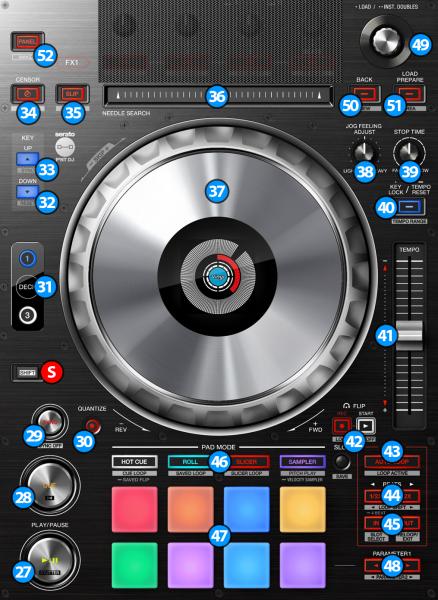
- PLAY/PAUSE. Plays / Pauses the track. Press and hold SHIFT and then press this button to "stutter-play" the track from the last set Cue Point.
- CUE. When the Deck is paused, you can set a temporary Cue Point by moving the Platter to place the Audio Pointer at the desired location and then pressing the Cue Button. During playback, you can press the Cue Button to return the track to this Cue Point. (If you did not set a Cue Point, then it will return to the beginning of the track.). If the Deck is paused, you can press and hold the Cue Button to play the track from the Temporary Cue Point. Releasing the Cue Button will return the track to the temporary Cue Point and pause it. To continue playback without returning to the Temporary Cue Point, press and hold the Cue Button, then press and hold the Play Button, and then release both buttons.
Hold down SHIFT and then press this button to return to the beginning of the track. - SYNC. Press this button to automatically match the corresponding Deck's tempo with the opposite Deck's (or the Master Deck’s if using a 4 decks Skin) tempo and phase. Hold down SHIFT and press this button to set this deck as Master Deck (for 4 decks skins).
- QUANTIZE. Press this button to toggle Quantize on/off. When Quantize is enabled, setting loops, jumping between hot cue points and starting playback of the deck will snap to the grid (CBG) of the track.
- S SHIFT. Press and hold this button to access secondary functions (black lettering in gray box) of other controls on the DDJ-SZ2
- DECK SELECT. Switch Left decks (1 and 3) and Right Decks (2 and 4).
- KEY DOWN. Press this button to decrease the musical Key of the track by 1 semitone. Hold down SHIFT and press this button to reset the track to it's original musical Key.
- KEY UP. Press this button to increase the musical Key of the track by 1 semitone. Hold down SHIFT and press this button to alter the key of this deck to match the master deck. The change of the key will be the minimum change required for the two keys to match each other.
- CENSOR. Press and hold this button to play the track backwards. On release the track will continue from the position it would have been if the button was never pressed. Hold down SHIFT and press this button (momentarily) to play the track backwards. Press again to return to forward direction.
- SLIP. Enables Slip Mode. Several software functions (such as Jogwheel movements, HotCues and Loops) will apply temporary on the track, and the track will return to the position it would have been if those functions were not triggered. Hold down SHIFT and press this button to toggle between the Scratch and Bend Jogwheel modes.
- NEEDLE SEARCH STRIP. The length of this strip represents the length of the entire track. Place your finger on a point along this sensor to jump to that point in the track (song position). While your finger touches the strip, the track will start a temporary playback (if it was not playing before) in order to preview that area of the track. Lift your finger from the strip to stop playback.
Important notice: In order to avoid accidental track jumps when you manipulate FX, the needle search does not operate when the deck is on air. If you want to use the strip while a deck is on air please hold down SHIFT first, and then touch the strip. You can change this behavior by changing the Needle Search Security setting. (See Special Settings) - JOGWHEEL. Touch sensitive platter for scratching (vinyl mode), bending (CD Mode) or Grid adjust.
The outer white/blue leds will start blinking if the track reaches 30 seconds before the end.
The inner white leds will rotate according to the software jogwheel position.
The inner red ring indicates the loop's progress bar if a loop is active, or current hotcue's position on the jogwheel rotation. - JOG FEELING ADJUST. Adjust the tension of the jogwheel (hardware operation)
- VINYL SPEED ADJUST. Adjust the time needed for the track to reach to full stop when PLAY/PAUSE (27) button is used to stop the deck (vinyl brake)
- MASTER TEMPO. Press this button to "lock" the track's pitch to its original key. The track's tempo will remain at the speed designated by the Pitch Fader. Hold this button down for more than 1 second to slowly reset track's speed to 100%. Hold down SHIFT and press this button to cycle through the available pitch ranges (6%, 10%, 12% and 100%)
- TEMPO. Controls the track's playback tempo. The Up and Down arrow LEDs will turn on if the tempo position of the unit and the actual tempo of the software do not match. While one of these LEDs is on, the tempo slider of the DDJ-SZ2 will not control the tempo of the deck until it meets the software value (soft take-over). Move the unit's tempo slider towards the direction of the LED that's turned on until it turns off. Now you can use the unit's tempo slider to adjust the tempo of the software.
- FLIP. These buttons are not used by VirtualDj
- AUTO BEAT LOOP. Sets an Automatic loop where it's length equals the current loop length as seen in VirtualDj GUI. You can use the LOOP HALF/DOUBLE (44) buttons to adjust the length of the auto loop. Hold down SHIFT and press this button to activate a Saved Loop.
- LOOP HALF/DOUBLE. Halves/Doubles the size of the current active loop, or the predefined loop length used by AUTO BEAT LOOP (43) button. Hold down SHIFT and press these buttons when a loop is active to move the loop forward or backwards as many beats as it's current length.
- LOOP IN/OUT. Use these buttons to set a Loop In and a Loop Out point (for manual looping).
Hold down SHIFT and press the "IN" button to jump back to the last "Loop In" point.
Hold down SHIFT and press the "OUT" button to cancel and exit the current loop -if the track is in loop- or reactivate the last used loop otherwise. - PAD MODE. Switch the pads of the unit to various modes (see PADS)
- PADS. Offer various operations, depending on the PADs Mode (see PADS)
- PARAMETERS. Offer various operations, depending on the PADs Mode (see PADS)
BROWSER CONTROLS
- BROWSE.
Turn: Scrolls through files or folders.
Push: Loads the currently selected track on the deck. Press this button twice (double click) to clone the track from the other deck. Hold down SHIFT and press this knob down to zoom the browser. - BACK. Sets focus to the Folders list. If focus is on the Folders list, set focus on the Songs list.
Hold down SHIFT and press this button to cycle though the available Sideview lists (Automix, Sidelist, Karaoke, Sampler and Clone). - LOAD PREPARE. Loads the currently selected track on the playlist.
Hold down SHIFT and press this button to cycle between, songs, sideview, and folder windows of the browser.
OTHERS
- PANEL. Press this button to cycle through the available mixer panels on VirtualDj GUI (Mixer, Video, Scratch and Master). Hold down SHIFT and press this button to switch the Sideview list to Sampler View.
EFFECTS

Each one of the FX unit offers 2 modes. The Single Effect mode that offers one effect slot but more parameters controls per effect, and the Multi Effects mode that offers 3 effect slots (to trigger more than 1 effect at the same time – chained effects).
The selection between those 2 modes is done by holding down SHIFT button and pressing the TAP (59) button down.
SINGLE EFFECT MODE
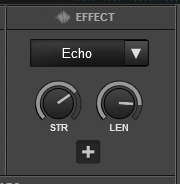

In this mode a single Effect is controlled with up to 6 Parameters and 4 Effect buttons. Only the first 2 Parameters are visible on the GUI. More Parameters and Effect buttons can be viewed in the FX GUI (opened from the + button on the GUI)
- FX1 knob. Controls the 1st effect parameter of the selected effect.
Hold down Shift and turn the knob to control the 4th effect parameter of the selected effect (if available). - FX2 knob. Controls the 2nd effect parameter of the selected effect (if available).
Hold down Shift and turn the knob to control the 5th effect parameter of the selected effect (if available). - FX3 knob. Controls the 3rd effect parameter of the selected effect (if available).
Hold down Shift and turn the knob to control the 6th effect parameter of the selected effect (if available).
- FX1 ON. Enables/disables the selected effect.
Hold down Shift and press this button to select the next available effect. - FX2 ON. Enables/disables the 1st effect button of the selected effect (if available).
Hold down Shift and press this button to enable/disable the 3rd effect button of the selected effect (if available). - FX3 ON. Enables/disables the 2nd effect button of the selected effect (if available).
Hold down Shift and press this button to enable/disable the 4th effect button of the selected effect (if available).
MULTI EFFECTS MODE
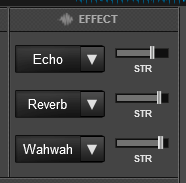

In this mode 3 different Effects can be applied and controlled with up to 2 Parameters for each FX slot. Only the first Parameter is visible on the GUI (and the 2nd Parameter while SHIFT is held on the DDJ-SZ2). More Parameters and Effect buttons can be viewed in the FX GUI (opened from the + button on the GUI)
- FX1 knob. Controls the 1st effect parameter of the selected effect of slot 1.
Hold down Shift and turn the knob to control the 2nd effect parameter of the selected effect of slot 1 (if available). - FX2 knob. Controls the 1st effect parameter of the selected effect of slot 2.
Hold down Shift and turn the knob to control the 2nd effect parameter of the selected effect of slot 2 (if available). - FX3 knob. Controls the 1st effect parameter of the selected effect of slot 3.
Hold down Shift and turn the knob to control the 2nd effect parameter of the selected effect of slot 3 (if available).
- FX1 ON. Enable/disable the selected effect of slot 1.
Hold down Shift and press this button to select the next available effect for slot 1. - FX2 ON. Enable/disable the selected effect of slot 2.
Hold down Shift and press this button to select the next available effect for slot 2. - FX3 ON. Enable/disable the selected effect of slot 3.
Hold down Shift and press this button to select the next available effect for slot 3.
OTHER FX KEYS
- BEATS.
Turn: Adjust the Beats of Beat-aware Effects. Please note that this function will work only with effects that support it. Hold down Shift and turn the knob to jump backwards or forward in the track on 4 beats steps.
Push: Select 4 beats as the beat length of a Beat-aware effect. Hold down Shift and push the knob to jump one beat back and one beat forward at each press (Beat Juggle)
- TAP. Press this button a few times to manually tap the tempo of the track.
Hold down Shift and then press this button to toggle between the Single and Multi Effect modes.
PADS
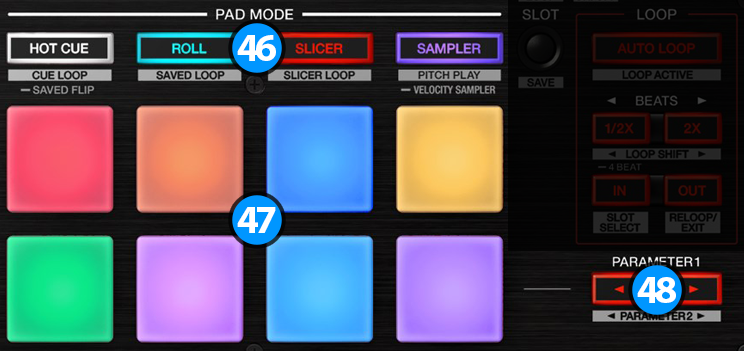
The 8 RGB Pads offer various functions, depending on the selected Pad mode. Each of the 4 Pad Mode buttons (46) offers 2 individual modes (hold SHIFT and then press the PAD MODE button to access the additional mode) while HOTCUE and SAMPLER offer an additional 3rd layer mode. The modes represent a page of the PADS section on the default VirtualDJ GUI.
- PAD MODE. Press any of the 4 available Pad mode buttons to set the Pads to Hotcues, Loop Roll, Slicer or Sampler mode.
Hold SHIFT and then press any of the 4 available Pad mode buttons to set the Pads to Cue Loop, Saved Loops, Beat Jump or Key Cue mode.
Finally hold HOTCUE mode button for more than 1 sec to set the pads to Remix Points mode, or hold the SAMPLER mode button more than 1 sec to set the pads to Velocity Sampler mode. - PADS. The 8 Pads offer different functionality depending on the selected mode. See next chapters for further details.
- PARAMETER. These buttons control the Parameters of the selected Pad mode.
PADS - HOTCUES
Press the HOT CUE mode button to set the PADs to HotCues mode.
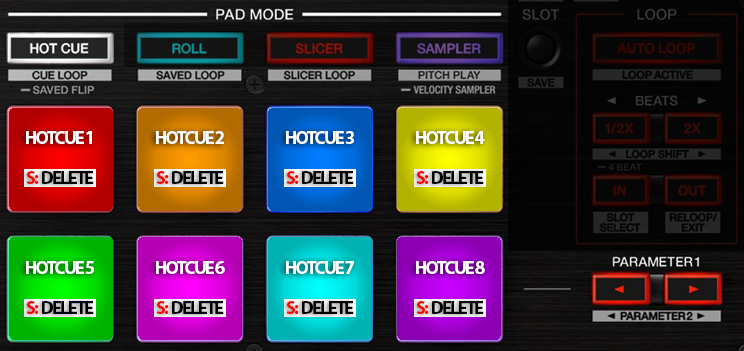
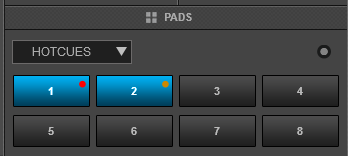
Each one of the 8 pad assigns a Hot Cue Point (1 to 8) or jumps the track to that Hot Cue Point (if assigned).
When a Hot Cue Button is unlit, you can assign a Hot Cue Point by pressing it at the desired point in your track. Once it is assigned, the Hot Cue Button will light on.
The color of the Pad depends on the setting nonColoredPOI or the assigned color from the POI Editor
Hold SHIFT and then press a pad to delete its assigned Hot Cue Point.
Use the PARAMETER buttons to jump the song to the previous/next assigned HotCue point.
Hold SHIFT and then use the PARAMETER buttons to jump 1 beat backwards/forward.
Read further details about Pads in the VirtualDJ 8 manual
PADS - LOOP ROLL
Press the ROLL mode button to set the PADs to Loop Roll mode.
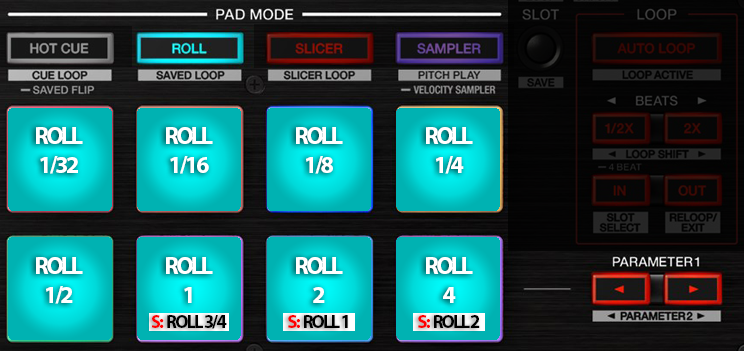
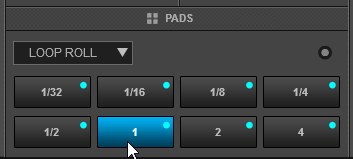
Press one of the 8 pads to trigger a momentary Loop Roll. Once the Pad is released, the track will resume playing from the position it would have been if the Loop Roll was never triggered. The exit point will be visible on the waveform of the VirtualDJ GUI with an additional “running” play marker.
Hold SHIFT to get ½, ¾, 1 and 2 beats Loop Roll sizes for the 4 lower pads.
Use the Page menu to apply the Loop Rolls to Video.
The PARAMETER buttons are not used in this mode.
Read further details about Pads in the VirtualDJ 8 manual
PADS - SLICER
Press the SLICER mode button to set the PADs to Slicer mode.
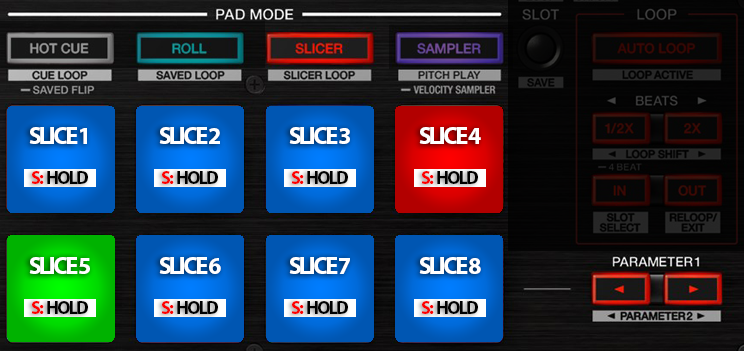
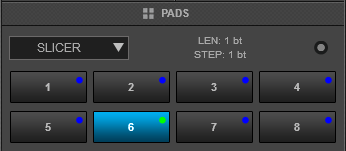
The 8 pads represent eight sequential beats—"Slices"—in the Beat Grid. The currently playing Slice is represented by the currently green lit pad. The light will move through the pads as it progresses through each eight-Slice phrase. Press a pad to repeat that Slice (hold it down if you want to keep looping it).
Once the Pad is released the track will continue to play from the position it would have been if the pad was never pressed.
Hold SHIFT and then use the Pads to repeat the memorized Slices (the Slices played/repeated last time)
Use the PARAMETER buttons to adjust the length of the Loop applied to the slice.
Hold SHIFT down and then use the PARAMETER buttons to adjust the step of the Slices
Read further details about Pads in the VirtualDJ 8 manual
PADS - SAMPLER
Press the SAMPLER button to set the PADs to Sampler mode.
Hold the SAMPLER button down for more than 1 second to set the PADs to Velocity Sampler mode.
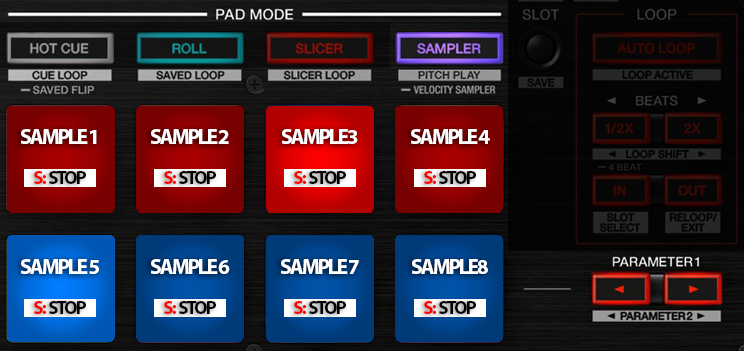
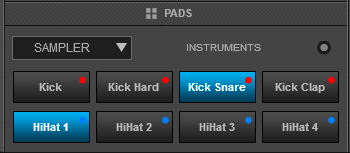
Each one of the 8 pads triggers a sample from the selected Sampler Bank of VirtualDJ. If a bank has less than 9 samples, both sides of DDJ-SZ2 will control the same samples. If a bank has more than 8 samples, the left side of DDJ-SZ2 will control samples 1 to 8 and the right side samples 9 to 16. The PAD will be lit if a sample slot is loaded and will blink if triggered.
Press the pads to trigger a sample. Depending on the selected trigger Pad mode, use SHIFT and the same pads to stop the sample.
If Velocity Sampler is enabled the volume of each sample will be controlled by the velocity used to hit the pad.
Use the PARAMETER buttons to select the Sampler Bank (previous/next).
Hold SHIFT down and then the PARAMETER buttons to select the Trigger Pad mode (on/off, hold, stutter, unmute)
Read further details about Pads in the VirtualDJ 8 manual
Read further details about Sampler in the VirtualDJ 8 manual
PADS - CUE LOOP
Hold SHIFT down and then press the HOTCUE button to set the PADs to Cue Loop mode.
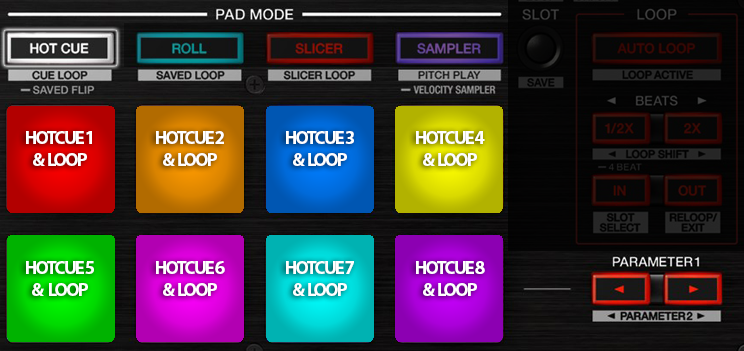
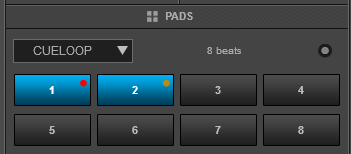
In this mode each one of the 8 pads assigns a Hot Cue Point or jumps the track to that Hot Cue Point, but in both cases, it also triggers a Loop (momentary or toggle depending on the selected mode from the Page menu).
By default the Cue Loops will be quantized. This can be turned off/on from the Page Menu on the GUI.
Hold SHIFT and then press a pad to stutter/jump to the Hotcue (loop will remain triggered)
Use the PARAMETER buttons to half/double the size of the triggered Loop.
Hold SHIFT and then use the PARAMETER buttons to select the On/Off (Toggle) or Hold (momentary) Loop trigger mode.
Read further details about Pads in the VirtualDJ 8 manual
PADS - SAVED LOOPS
Hold SHIFT and then press the ROLL mode button to set the PADs to Saved Loops mode.
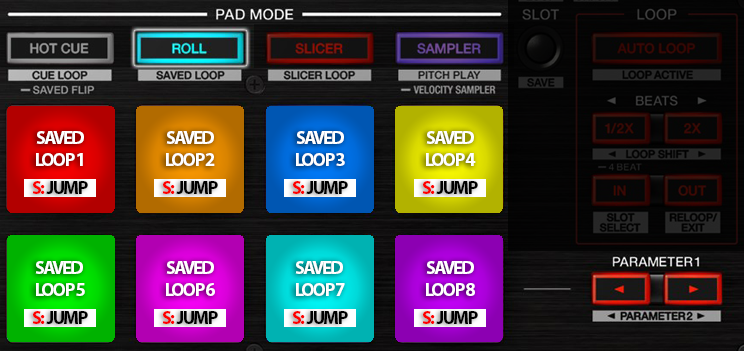
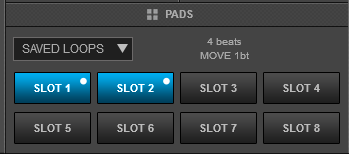
Each one of the 8 pad represents a slot to save and recall a loop.
Press a Pad to save (and trigger at the same time - if not already) a Loop at the current position.
Hold the same Pad down for more than 2 seconds to delete the saved loop from the slot.
When a Loop is saved to a slot, use the same Pad to load* (enable) the saved loop, but not jump to its position if the loop is saved to a later position than the current one (loop load and prepare).
Hold SHIFT and then use the same Pad to load* (enable) the saved loop, and jump to its position.
*Note that only 1 Loop can be enabled each time.
Use the PARAMETER buttons (48) to half/double the size of the Loop.
Hold SHIFT and then use the PARAMETER buttons (48) to move the Loop back/forth in time by 1 beat steps.
Read further details about Pads in the VirtualDJ 8 manual
PADS - BEAT JUMP
Hold SHIFT and then press the SLICER mode button to set the PADs to Beat Jump mode.
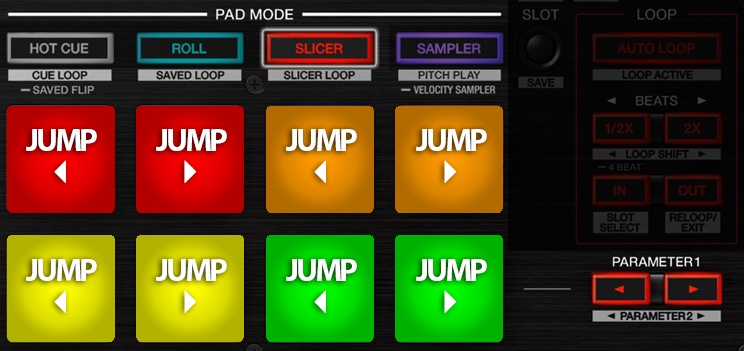
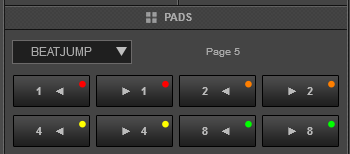
In this mode, the 8 Pads will jump the track backwards/forward by the amount of beats depending on the selected Beatjump page (from 1/8 beats to 32 Bars)
Use the PARAMETER buttons to select the Beat Jump bank page (previous/next).
Read further details about Pads in the VirtualDJ 8 manual
PADS - KEY CUE
Hold SHIFT and then press the SAMPLER mode button to set the PADs to Key Cue mode.
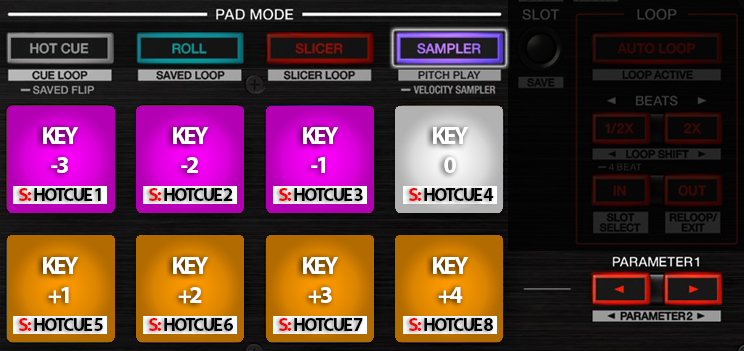
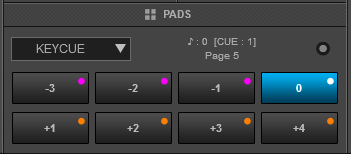
Each of the 8 Pads triggers the selected Hotcue point (or the Temporary Cue if none selected or not available) at a selected Key semitone (from -7 to +7).
Eight different pages/banks are offered with various semitone values to use and a 0 value in order to reset the key to its original value is always offered in all pages.
Each time a Pad is pressed, the track will jump to the selected Hotcue point and will also alter the Key of the track to the value designated by its assigned value.
Hold SHIFT and then press a Pad in order to select a different Hotcue for the Key pads to trigger.
Use the PARAMETER buttons to adjust the Key of the track without triggering the Hotcue.
Hold SHIFT and then use the PARAMETER buttons to select a different page/bank with different key semitone values.
Read further details about Pads in the VirtualDJ 8 manual
PADS - REMIX POINTS
Hold HOT CUE mode button down for more than one second to set the PADs to Remix Points mode.
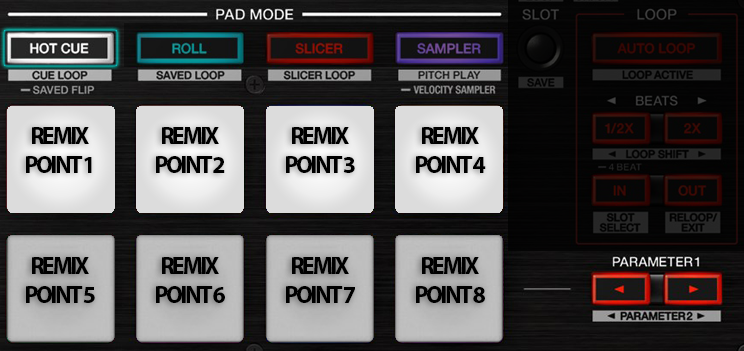
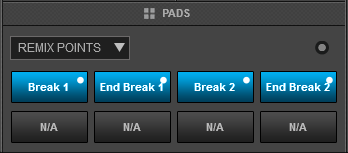
This mode offers the first 8 Remix Points of the loaded track. Remix Points are automatically defined from VirtualDJ, once the track is analyzed. Remix points can be managed from the POI Editor (more can be added/adjusted/deleted). They usually represent End/Start points of track’s blocks depending on the structure of the track and are always quantized when triggered.
The Remix points will be visible on the Song-position progress of the GUI (with white markers) once the Remix Points Pad page is selected.
Read further details about Pads in the VirtualDJ 8 manual
Read further details about Remix Points in the VirtualDJ 8 manual
Front - Rear


- MASTER OUT1: Master signal output connectors (XLR – Balanced). Use this to connect on your pro grade amplifier or self-powered speakers.
- MASTER OUT2: Master signal output connectors (RCA – Unbalanced). Use it to connect with another mixer, or consumer grade amplifier.
- BOOTH OUT: Booth signal output (TRS – Balanced). The strength of the signal is controlled by “BOOTH MONITOR LEVEL” knob (15) on the mixer section. Use it to connect your booth speakers, or an amp that needs different sound output level than master output.
- GND SCREW: Use it to screw your GND (ground) cable from turntables that provide it in order to eliminate GND static noise.
- CH4 INPUTS: Connect an analog source on CH4 of the DDJ-SZ2 mixer. You can connect a turntable or a CD-Player. The input is selectable via “INPUT SELECT SWITCH” (10) on the mixer section
- CH2 INPUT: Connect an analog source on CH2 of DDJ-SZ2 Mixer. You can only connect a CD-Player, or a similar line level device.
- CH1 INPUT: Connect an analog source on CH1 of DDJ-SZ2 Mixer. You can only connect a CD-Player, or a similar line level device.
- CH3 INPUTS: Connect an analog source on CH3 of the DDJ-SZ2 mixer. You can connect a turntable or a CD-Player.
- MIC 1 INPUT: Connect a mic on the DDJ-SZ2 mixer. You can use XLR or Jack (TRS) connectors.
- MIC 2 INPUT: Connect a mic on the DDJ-SZ2 mixer. You can use only a Jack (TRS) connector.
- USB B CONNECTOR: Use a standard USB cable to connect DDJ-SZ2 with your computer.
- USB A CONNECTOR: Use a standard USB cable to connect DDJ-SZ2 with your computer.
- POWER SWITCH: Turns on/off the power on the device. Please turn on the device only after doing and securing all connections on the back.
- AC INPUT: Connect an IEC power supply cable
- HEADPHONES CONNECTOR: Connect your headphones. Both sizes (3.5mm and 6.35mm ( 1⁄4 in)) are offered.
- CROSSFADER CURVE ADJUST: Adjusts the curve of the crossfader
Advanced Audio Options
Pioneer DDJ-SZ2 offers a variety of Inputs and Operation modes. The unit can operate both as MIDI and a stand-alone hardware mixer at the same time, allowing mixing from analogue media sources (CD Players, Turntables etc) connected to one of the 4 available inputs at the rear panel, along with the ability to use a Computer DJ Application.
MIXER CHANNELS
Channel 3 (far left) :
Audio signal from an analogue line level source (such as a standard CD Player) connected to the CH 3 LINE inputs at the rear panel can be inserted and processed by the mixer when the switcher at the top panel is set to Line position.
Audio signal from an analogue turntable source connected to the CH 3 PHONO inputs at the rear panel can be inserted and processed by the mixer when the switcher at the top panel is set to Phono position.
Audio signal from VirtualDJ Deck 3 can be routed to this Channel when the switcher at the top panel is set to USB position.
Channel 1 (middle-left) :
Audio signal from an analogue line level source (such as a standard CD Player) connected to the CH 1 LINE inputs at the rear panel can be inserted and processed by the mixer when the switcher at the top panel is set to Line position.
Audio signal from VirtualDJ Deck 1 can be routed to this Channel when the switcher at the top panel is set to USB position.
Channel 2 (middle-right) :
Audio signal from an analogue line level source (such as a standard CD Player) connected to the CH 2 LINE inputs at the rear panel can be inserted and processed by the mixer when the switcher at the top panel is set to Line position.
Audio signal from VirtualDJ Deck 2 can be routed to this Channel when the switcher at the top panel is set to USB position.
Channel 4 (far right) :
Audio signal from an analogue line level source (such as a standard CD Player) connected to the CH 4 LINE inputs at the rear panel can be inserted and processed by the mixer when the switcher at the top panel is set to Line position.
Audio signal from an analogue turntable source connected to the CH 4 PHONO inputs at the rear panel can be inserted and processed by the mixer when the switcher at the top panel is set to Phono position.
Audio signal from VirtualDJ Deck 4 can be routed to this Channel when the switcher at the top panel is set to USB position.
Notes :
- Each time a different source is selected from the top switchers, the audio signal of other sources on the same channel will be muted.
- Switch between various sources is smooth, providing the ability of back-to-back dj changeover.
- When the corresponding channels are set to USB position and there are two computers connected on the DDJ-SZ2, the USB A/B buttons on the top of the mixer allow smooth transitions between different DJ's. When one of the USB A/B buttons is pressed for one of the sides of DDJ-SZ2 then both of that side channels are muted for the computer that has not the control anymore.
Recording & Broadcasting
The unit offers the ability to record the Master Output along with the Microphone and LINE Inputs directly from VirtualDJ record button (in the MASTER center panel). The dedicated Recording input channel is already pre-configured, so no further adjustments need to be done.
Note :
The recording audio level depends on the "USB Ouput Level" setting in DDJ-SZ2 Settings Utility application, and by default it's set to -19db to provide enough headroom on your recordings. We strongly advise to keep the default setting while recording, but if you find your recordings too quiet then you may want to change this value to a higher setting.
MICROPHONE INPUTS
DDJ-SZ2 offers 2 Microphone Inputs and Level/EQ controls from the top panel. Both audio signals from these inputs are directly routed to the Master Output of the unit.
The Microphone inputs are not part of the USB Audio interface, so these cannot be added in VirtualDJ Audio setup and will not control the software Microphone section in the MASTER panel of VirtualDJ GUI and vice versa.
However, as mentioned in the Recording section, both Microphone Inputs can be recorded via the REC button of VirtualDJ via the dedicated recording input channel of the Audio interface.
TROUBLESHOOTING - FAQ
TROUBLESHOOTING - FAQ
- I can't prelisten a song. PFL buttons do nothing
[list] - Please ensure that you are using the default audio setup for DDJ-SZ2 as shown in the Installation chapter of this manual.
[/list]
